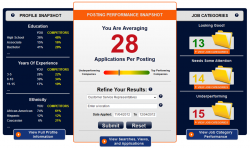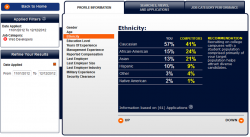 Quick quiz: Your job postings for customer service reps on average get 28 applications each. Is that good or bad?
Quick quiz: Your job postings for customer service reps on average get 28 applications each. Is that good or bad?
If you answer is along the lines of “I don’t know,” CareerBuilder has a solution for you. Any employer with a job posting can now see how well their ad performs against every other similar ad in the CareerBuilder network. Free.
That alone is pretty cool, since knowing your ads for customer service reps draw fewer applications than your competitors get is important business intelligence. But as the cliche goes, “Wait, there’s more!” Besides the raw counts, CareerBuilder’s new Recruitment Performance Portal tells you at a glance how experienced they are, how educated, as well as ethnicity, gender, and a fairly broad range of other details.
Over the years, says Hope Gurion, CareerBuilder’s chief development officer, the most frequently asked questions from employers have been about the performance of their online postings. Regularly, CareerBuilder would package up the data about searches, ad views, applications, and other metrics and provide it to employer clients on a spreadsheet.
Missing was any comparison to others advertising similar jobs.
“To me,” says Gurion, “the most important thing I can do with this data is to compare … So we invested this recruitment performance portal.”
The near real-time data is graphically presented for ease of use. At a glance, even a casual user can tell how well a particular ad is doing and how the results compare to the industry. While 28 applicants is at the low end in terms of volume, the candidates are better educated and have more experience than the average of what other customer service rep ads attract. For that employer, trading volume for those quality indicators could be a winning combination.
But now how does CareerBuilder know so much about the applicants?
 “We have a lot of information collection points,” Gurion explains, beginning with the millions and millions of resumes in the CareerBuilder database. Most applicants will use their CareerBuilder resume to one-click apply to a job. That data is combined with other information the applicant may provide in other ways, say as part of screening questions, and possibly geolocation via their IP address. Cookies track users from entry to exit and lets CareerBuilder know what searches they did to find each ad.
“We have a lot of information collection points,” Gurion explains, beginning with the millions and millions of resumes in the CareerBuilder database. Most applicants will use their CareerBuilder resume to one-click apply to a job. That data is combined with other information the applicant may provide in other ways, say as part of screening questions, and possibly geolocation via their IP address. Cookies track users from entry to exit and lets CareerBuilder know what searches they did to find each ad.
“Billions of data points” are collected and synthesized into the portal information, adds Gurion. The goal, she explains, is to help employers craft more effective ads.The Recruitment Performance Portal tells recruiters whether “my job is doing better or worse than others. (The data) gives you clues so you can go and hunt and see what the problem is,” Gurion says, referring to underperfoming ads.
It may be a matter of wording, or presentation. Want to make a change, but aren’t sure what might work better? The portal tells you who else is advertising so a user can check other ads for inspiration.
The information about other ads is anonymized, so no one will know how any individual employer or ad does. But just seeing the differences among the ads should be help enough.
Says Gurion in the official announcement going out today: “We’re applying the power of Big Data, making it easy for clients to optimize recruitment strategies to gain competitive advantage and better engage desirable talent. The portal offers companies information that is invaluable in developing a more effective recruiting program by not only evaluating their own applicants, but also benchmarking their recruitment efforts against competitors.”